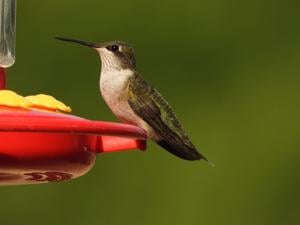
Ruby-throated Hummingbird migration has begun and we’ve been seeing them regularly at the Gulf Coast Bird Observatory, visiting our feeders. If you enjoy putting out sugar water for these birds, be sure to do it in August through October. Ruby-throated Hummingbirds are not only charming and cute, they also have some of the most unique features in the bird kingdom.
For such a small animal, they are actually quite smart. Ruby-throats have a great memory, and can remember the location of different food sources, and how to get there. A hummingbird’s brain is about 4.

2% of their body weight, giving these birds the largest brain-to-body proportion of any bird. Another noticeable feature is the Ruby-throated hummingbird’s long beak. They use it to reach inside long tubular flowers and drink the nectar inside.
There is a common misconception that the long beak is used as a straw to slurp up the liquid. But in reality, hummingbirds use their very long tongues to lap up the nectar, similar to the way a dog does. If you haven’t seen a hummingbird licking up sugar water, it might be because they move too quickly to see; hummingbirds can lick up to 13 times per second.
One lesser-known feature is the hummingbird’s heart. It can make up 2.5% of the total body weight.
For comparison, the human heart is less than 1% of our total body weight. Their hearts are fast too; they beat at about 1,260 beats per minute when the birds are in flight. For comparison, the resting heart rate of human is about 60-100 beats per minute.
Hummingbirds can fly forward, backward, upside-down and hover, making them some of the most acrobatic fliers in the bird kingdom. Some hummingbirds can flap their wings 200 times per second, giving them the record for most wing beats per minute of any bird. This fast propulsion comes in handy during their impressive migration.
Ruby-throated Hummingbirds begin their southward migration in August and continue into October. Mid-September is the peak of their journey, and coastal Texas gets a ton of them passing through. Because they breed as far north as central Canada and the majority of them spend the winter in Mexico and Central America, the Ruby-throats fly an incredible distance every spring and fall.
It can be a journey as long as 1,000 miles twice a year between their wintering and breeding grounds. Fortunately for us, Lake Jackson is in the middle of their migration flight path. Gulf Coast Bird Observatory headquarters is flooded with hummingbirds every September, which is why we host our Xtreme Hummingbird Xtravaganza on the second and third Saturdays of the month.
This year, the festival will be held on September 14 and 21 from 8 am to 12 pm. Come by to see live hummingbird banding for our research, fun kids’ activities, nature booths, and a whole lot of hummingbirds. Tickets are $5 and can be purchased upon entry.
Learn more on our website, www.GCBO.org .
.














